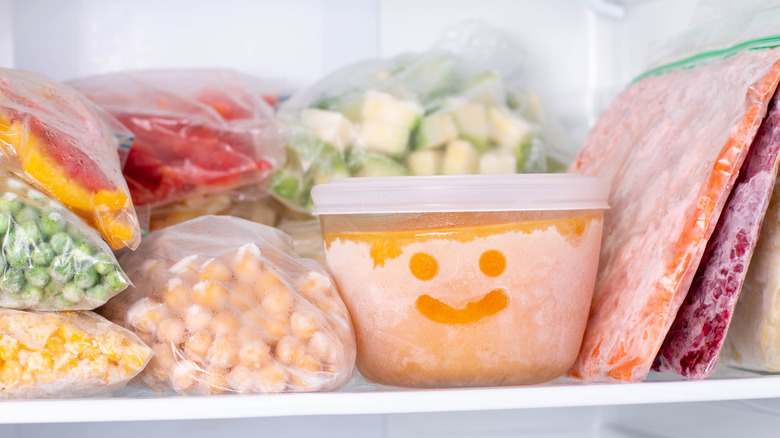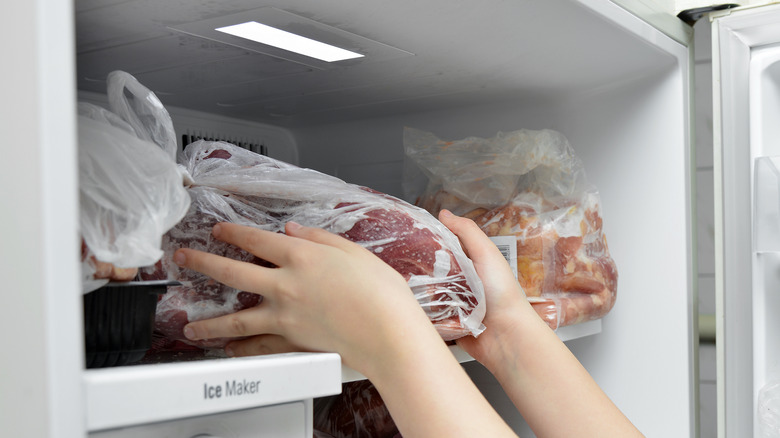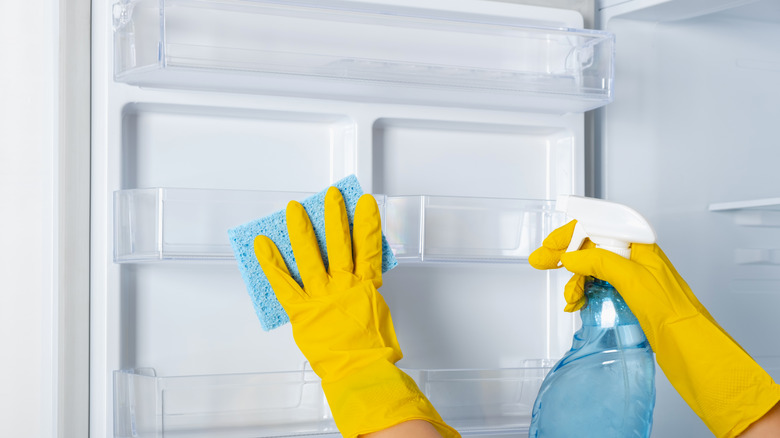How To Properly Clean Your Freezer
It can be easy to neglect last night's leftovers after they've been packed up and placed in the freezer. Once those frozen peas are tucked away behind new cartons of ice cream, the chances of remembering them are pretty slim.
In fact, as reported by Newsweek, one woman found blackberries in her in-laws' freezer dating back to 1972 as well as plenty of other forgotten foods, like egg yolks, applesauce, and more — many from the 1980s and 1990s.
Even if your freezer bags haven't been collecting frost for half a century, the task of cleaning out those shelves may feel daunting. Regardless, it's important to keep your freezer sanitary just like you would any other place you store food. Maybe you'll even put together a new recipe with the frozen foods you rediscover.
But, before you can get cooking, you have to clean out your freezer first. Here's the best way to do it.
Deep clean your freezer once a year
According to Kate Mummaw, kitchen expert at the Whirlpool Corporation, most freezers need a deep cleaning once every year at a minimum, per Today. However, if there's been a recent power outage, make sure to go through your freezer right away to take care of any items that have thawed and spoiled.
When cleaning your freezer, it's important to defrost and unplug it first (via Food Network). Cleaning while it's plugged in can damage the appliance (via Today), and all that cold air pouring out would be a waste of money and energy.
However, "if you are cleaning the freezer that is adjacent to your fridge, don't worry about it being unplugged," according to The Home Depot. Items will stay cold for hours if you simply keep the fridge door shut.
Next, transfer frozen products into a cooler for the duration of the cleaning. The Food Network warns that water may drip from the freezer as it defrosts, so place a towel below the appliance to soak up potential moisture. While the freezer is beginning to defrost — the process can take a few hours — remove any detachable shelves, and give them a scrub in your sink with soap and water (via Taste of Home).
Once your freezer has been emptied and defrosted, it's time to move on to sanitizing.
Properly clean with a homemade solution
It's important not to use potentially-harmful cleaners like bleach on the inside of your freezer (via Today). This is where you keep your food, after all, and harsh chemicals can damage your freezer.
Instead, create a DIY cleaning solution. Taste of Home suggests mixing equal parts hot water and vinegar for a natural, food-safe cleaner, but you can also use soapy water, per The Home Depot. Place your cleaning solution in an empty spray bottle, spritz the inside of the appliance, and wipe with a microfiber towel or sponge.
If you encounter stubborn stains, Taste of Home recommends using a Magic Eraser, while sticky areas can be tackled with a toothbrush and hot water (via The Home Depot). If you use soap, wash the surface again with just water so you don't leave any soapy residue behind.
After all the surfaces have been scrubbed, thoroughly dry them with a clean dish towel or paper towel. It's important that cleaning solutions or water don't freeze when the appliance is turned back on. Once dry, place shelving and drawers back where they belong.
Now, it's time to plug in your freezer and move the food back in. Make sure all products are in food-safe storage containers — for example, it's not a good idea to freeze food in glass jars – and decide what you want to keep and what might need to be thrown away.
With an organized freezer, you'll be able to see what you have on hand more easily. This way, you won't lose track of applesauce from the 1980s. Today suggests leaving space between your freezer walls and food products, which allows for airflow and reduces freezer burn.
Though a deep clean is only necessary once or twice a year, it can be helpful to do a mini-clean weekly. With these shorter scrub-downs, it's not necessary to defrost your appliance. Simply wipe spills and check the door's seal, which, according to Taste of Home, can easily collect food debris and prevent the freezer from properly closing.


